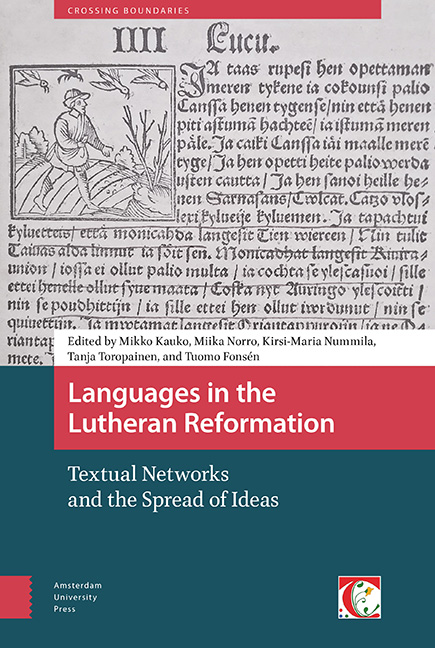Book contents
- Frontmatter
- Contents
- List of Figures and Tables
- Preface
- Introduction
- Part I The Reception of Luther's Ideas and their Influence for the Development of Written Languages
- Part II Effects of Bible Translations on the Evolution of Written Language
- Part III Reuse of (Catholic) Texts after the Reformation
- Part IV Language Contacts and Loanwords
- Index
8 - Early Finnish Translations of the Hymn Te Deum Laudamus
Published online by Cambridge University Press: 21 November 2020
- Frontmatter
- Contents
- List of Figures and Tables
- Preface
- Introduction
- Part I The Reception of Luther's Ideas and their Influence for the Development of Written Languages
- Part II Effects of Bible Translations on the Evolution of Written Language
- Part III Reuse of (Catholic) Texts after the Reformation
- Part IV Language Contacts and Loanwords
- Index
Summary
Abstract
This essay discusses early Finnish translations of the Latin hymn Te Deum laudamus. The hymn, dating from the time of the mediaeval Roman Catholic Church, has been translated into Finnish several times (e.g., in a prayer book of Mikael Agricola [1544] and in a hymn book of Jacobus Finno [1583]); these texts include both prose-type versions and a rhymed version of the hymn. From these versions we can see the change that took place when the Catholic choral singing tradition was replaced, in accordance with the Lutheran ideal, by the practice of chanting the hymn together as a congregation. The essay examines the relationship between the versions and considers the influence of the Latin, Swedish, and German versions on the Finnish translations. The translation in Agricola's prayer book is especially interesting because it contains features of the eastern dialect, which are rare in Old Literary Finnish, which is mostly based on the western dialects.
Keywords: Finnish, hymn translations, Mikael Agricola, Jakobus Finno
The Lutheran Reformation gradually reformed liturgical music and the style in which it was performed, revealed by vernacular languages beginning to be sung in church services in addition to Latin. This gave the congregation – at least in principle – the possibility of participating in singing (see Ross in this volume). The change was not radical, however, nor was it particularly quick, and church services initially retained much music in Latin. It was also a significant innovation that metric and rhymed songs began to be written. For the congregation, those songs were easier to sing together than the old prosaic hymns. One song that was both preserved and reformed was the age-old hymn Te Deum, which has been the most famous liturgical song in the Western Church. It has appeared in a variety of translations in different languages alongside its Latin form.
This study ascertains the number of different Finnish translations of Te Deum in 16th- and 17th-century music manuscripts and in the earliest Finnish books. It also examines the interrelationship between the translations, their dates of translation, and the influence of the source languages on the translations. While it is unknown whether there were any Finnish translations of Te Deum as early as the Middle Ages, certain features of the earliest translations suggest that they are relatively old.
- Type
- Chapter
- Information
- Languages in the Lutheran ReformationTextual Networks and the Spread of Ideas, pp. 191 - 214Publisher: Amsterdam University PressPrint publication year: 2019



